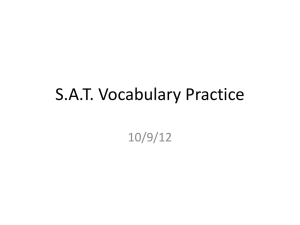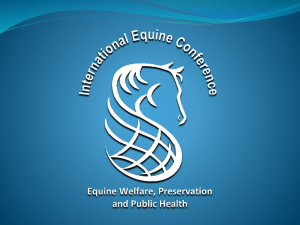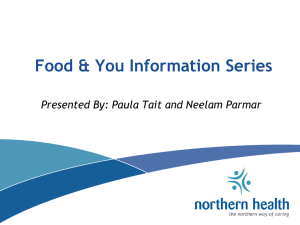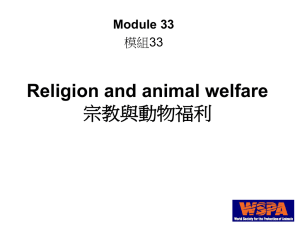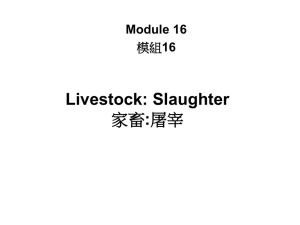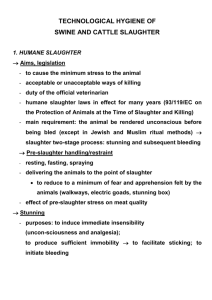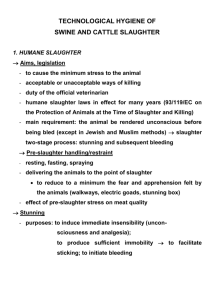Non-stun slaughter processes
advertisement
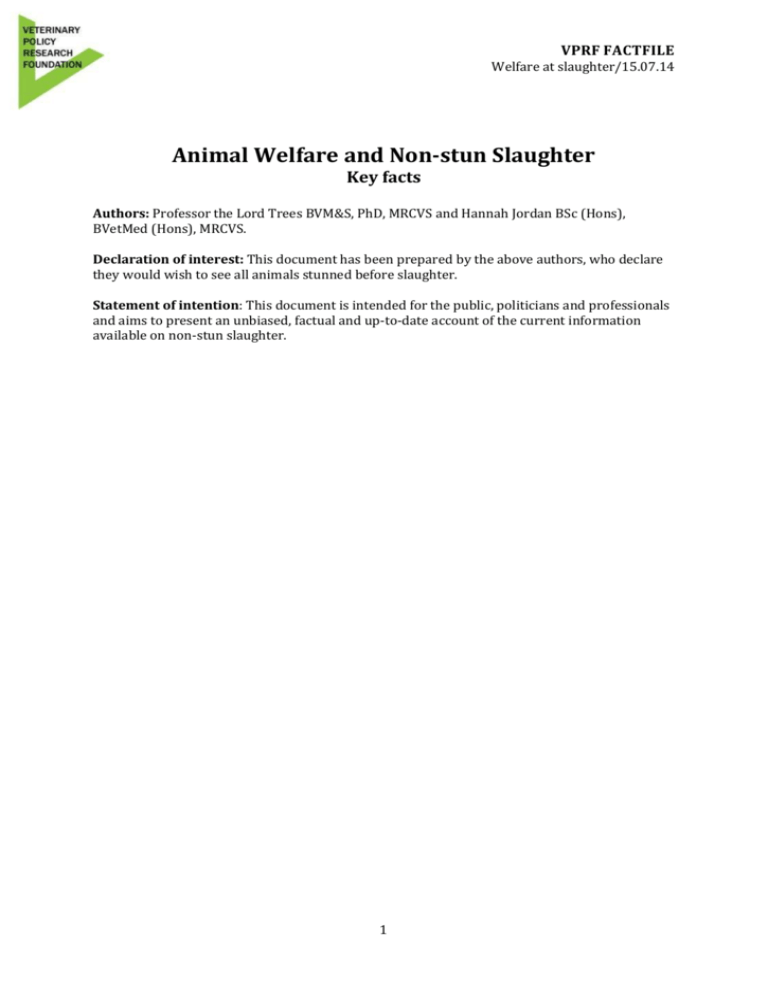
VPRF FACTFILE Welfare at slaughter/15.07.14 Animal Welfare and Non-stun Slaughter Key facts Authors: Professor the Lord Trees BVM&S, PhD, MRCVS and Hannah Jordan BSc (Hons), BVetMed (Hons), MRCVS. Declaration of interest: This document has been prepared by the above authors, who declare they would wish to see all animals stunned before slaughter. Statement of intention: This document is intended for the public, politicians and professionals and aims to present an unbiased, factual and up-to-date account of the current information available on non-stun slaughter. 1 VPRF FACTFILE Welfare at slaughter/15.07.14 Contents EC Regulation and UK Law ........................................................................................................................................... 3 Definitions & terminology............................................................................................................................................. 4 Stun slaughter process ................................................................................................................................................... 5 Stunning and bleeding out ............................................................................................................................................ 6 Non-stun slaughter processes ..................................................................................................................................... 7 Mis-stunning and mis-cutting ..................................................................................................................................... 9 Number of animals involved ..................................................................................................................................... 10 Basis of the religious proscription of stunning ................................................................................................. 11 Time to unconsciousness or collapse .................................................................................................................... 12 Evidence and opinion on pain and suffering at slaughter ............................................................................ 13 Standpoints of animal welfare groups, assurance bodies and UK supermarkets on non-stun slaughter and labelling ................................................................................................................................................ 16 2 VPRF FACTFILE Welfare at slaughter/15.07.14 EC Regulation and UK Law 1. The law governing the protection of animals at the time of killing is set out in Council Regulation (EC) 1099/2009 the Protection of Animals at the Time of Killing (PATOK) and applies in all EU Member States. 2. The Welfare of Animals at the Time of Killing (WATOK) Regulation 2012 came into effect on 1st January 2013 in Scotland, Wales and Northern Ireland. However, in England the Welfare of Animals (Slaughter or Killing) Regulations 1995 (WASK), as amended, currently applies where it sets higher standards than PATOK1 until such time as WATOK England regulations are in place. Following reconsideration by DEFRA Ministers,2 the proposed Draft WATOK England Regulations were revoked in May 2014 before they were due to come into force.3 3. PATOK requires that animals are stunned before slaughter. In Annex 1 of PATOK the accepted stunning methods are listed and parameters are specified for each method and species, an abridged version is shown in Table 1, page 6. The list does not include cutting the throat: “Animals shall only be killed after stunning in accordance with the methods and specific requirements related to the application of those methods […]. The loss of consciousness and sensibility shall be maintained until the death of the animal. The [stunning] methods referred to in Annex 1 which do not result in instantaneous death [...] shall be followed as quickly as possible by a procedure ensuring death such as bleeding, pithing, electrocution or prolonged exposure to anoxia.” Paragraph 1, Article 4, Chapter II of the EC Council Reg. No. 1099/2009 4. Recital 18 and Article 4 of the PATOK allows for Member States, should they choose, to provide an exemption from pre-slaughter stunning of animals for religious purposes4: “In the case of animals subject to particular methods of slaughter prescribed by religious rites, the requirements of Paragraph 1 [above] shall not apply provided the slaughter takes place in a slaughterhouse.” Paragraph 4, Article 4, Chapter II of the EC Council Reg. No. 1099/2009 5. The UK currently offers such an exemption from pre-slaughter stunning and a similar exemption will apply in the new regulation. Current UK WASK Regulations state5: “[…] references to slaughter by a religious method are references to slaughter without the infliction of unnecessary suffering – a) by the Jewish method for the food of Jews by a Jew who DEFRA (2012). Slaughter of livestock: welfare regulations – Detailed guidance. [Online]. Available: https://www.gov.uk/farm-animal-welfare-at-slaughter [Accessed: 18/06/2014]. 2 Whitehead, S. DEFRA Animal Welfare Team. Personal Communication. 21 st May 2014. 3 The Welfare of Animals at the Time of Killing (Revocation) Regulations 2014. SI 2014/1258. London: HM Government; 2014. [Online] Available: http://www.legislation.gov.uk/uksi/2014/1258/made [Accessed: 18/06/14]. 4 Council Regulation (EC) 1099/2009 of the 24 September 2009 on the protection of animals at the time of killing. Official Journal of the European Communities. L 303/1, 18.11.2009. [Online]. Available: http://eur-lex.europa.eu/LexUriServ/LexUriServ.do?uri=OJ:L:2009:303:0001:0030:EN:PDF [Accessed: 09/04/2014]. 5The Welfare of Animals (Slaughter or Killing) Regulations 1995, as amended. SI 1995/731. London: HM Govt; 1995. [Online] Available: http://www.legislation.gov.uk/uksi/1995/731/made [Accessed: 18/06/14] 1 3 VPRF FACTFILE Welfare at slaughter/15.07.14 holds a licence in accordance with Schedule 1...or; b) by the Muslim method for the food of Muslims by a Muslim who holds a licence in accordance with Schedule 1.” Schedule 12, Part I, Paragraph 2, WASK Regulations (1995) as amended “[Any bovine animal must be] in an upright position in a restraining pen which has been approved by the Minister. [For a pen to be approved it must] protect a bovine animal from any avoidable pain, suffering, agitation, injuries or contusions while confined in it or while entering it.” Schedule 12, Part II, Paragraph 3 & 4, WASK Regulations (1995) as amended “Any person engaged in the slaughter by a religious method of any animal must ensure that where the animal has not been stunned..., before bleeding it is not moved until it is unconscious and in any event not before the expiry of- (a) in the case of any sheep or goat, a period of not less than 20 seconds; and (b) in the case of any bovine animal, a period of not less than 30 seconds, after it has been slaughtered in the manner described in paragraph 6.” Schedule 12, Part II, Paragraph 7, WASK Regulations (1995) as amended 6. With reference to Paragraph 4 of this document, the following EU Member States do not allow any exemption from pre-slaughter stunning: Denmark, Lithuania, Malta, Poland, Slovenia and Sweden. Five other Member States have not practised non-stun slaughter since 2012: Cyprus, Estonia, Finland, Germany & Luxembourg. 6,7 Please refer to Appendix 2 for comments from the DIALREL study. 7. Globally, non-stun slaughter is not permitted in Switzerland, Norway and Iceland. 8,9 New Zealand requires all mammals to be stunned before slaughter, but offers an exemption for a fixed number of poultry only.10 Definitions & terminology 8. It is recommended to use ‘non-stun’ slaughter rather than ‘ritual’ or ‘religious’ slaughter. 9. Stunning: any intentionally induced process which causes loss of consciousness and sensibility without pain, including any process resulting in instantaneous death.11 10. Pre-cut stun: A stun prior to the throat cut. 11. Post-cut stun: A stun immediately after cutting the throat. 12. Reversible/simple stun: ‘any intentionally induced process which causes loss of consciousness and sensibility without pain’ that does not cause instantaneous death. Headonly electronarcosis is an accepted form of reversible stunning.12 Minor, J. European Commission UK Office. Evidence to the All-party Parliamentary Group for Beef & Lamb. Tuesday 10th June 2014. 7 Manchi, F. European Commission UK Office. Personal Communication. July 3 rd 2014. 8 Needham, C. (2012) Religious Slaughter of Animals in the EU. Library of the European Parliament, European Union. Report No. 120375REV2. 9 Ferrari, S., Bottoni, R., (2010). EC DIALREL Project, Deliverable 1.4, Legislation regarding religious slaughter in the EU member, candidate and associated countries. 10 Johnson, C. Professor of Neurophysiology, Massey University, New Zealand. Personal Communication. 15th January 2014. 11 Council Regulation (EC) 1099/2009 - Chapter 1, Article 2, item (f). 12 Council Regulation (EC) 1099/2009 - Chapter 1, Article 4, Clause 1. 6 4 VPRF FACTFILE Welfare at slaughter/15.07.14 13. Porging: applicable to kosher production, is the process of removing portions of the animal that are not kosher: the blood, certain fats (chailev) & the sciatic nerve (the gid hanasheh).13 14. Unconsciousness: an abnormal state of lack of response to sensory stimuli, resulting from injury, illness, shock or some other bodily disorder.14 15. Insensibility: not perceptible to the senses.15 16. False aneurysm: When a severed artery end retracts within its connective tissue sheath and the artery end becomes blocked or sealed.16 17. Mis-stunning: When a stun is not carried out correctly and the animal is not rendered immediately unconscious and insensitive to pain. 18. Sticking: To cut the throat and sever both carotid arteries and jugular veins of an animal to allow exsanguination.17 19. Mis-cutting: When one or both of the major blood vessels of an animal remains intact or is incompletely cut18 and there follows delayed exsanguination, and a non-stunned animal is not rendered immediately unconsciousness and insensitive to pain. Stun slaughter process 20. Figure 1 shows the standard stun slaughter process. Appropriate restraint Appropriate stun for species and age Insensibility Sticking and exsanguination Death Figure 1: Standard stun slaughter process 21. Different methods of stun are used for different species, as listed in Annex 1 of PATOK, to provide the most rapid and humane stun possible, and account for anatomical differences (see Table 1). In no regulations is cutting the throat listed as a stun method.19 Table 2 describes the most common method of stun by species. Zivotofsky, A., Z., (2010). EC DIALREL Project, Deliverable: 1.1, Religious rules and requirements – Judaism, Report (Part 1). 14 Studdert, V.P., Gay, C.C., Blood, D.C. Saunders Comprehensive Veterinary Dictionary, 4th Ed. UK: Elsevier Health Sciences. 2011. 15 Studdert, V.P., et al. Saunders Comprehensive Veterinary Dictionary, 4th Ed. 2011. 16 Gregory, N., Schuster, P., Mirabito, L., Kolesar, R., McManus, T. (2012). Arrested blood flow during false aneurysm formation in the carotid arteries of cattle slaughtered with and without stunning. Meat Science. 90: 368-372. 17 FAWC (2003). Report on the Welfare of Animals at Slaughter or Killing Part 1: Red Meat Animals. Defra publishing. [Online]. Available: http://www.fawc.org.uk/reports/pb8347.pdf [Accessed: 19/3/2014] 18 Gregory, N.G., von Wenzlawowicz, M., von Holleben, K., Fielding, H.R., Gibson, T.J., Mirabito, L., Kolesar, R. (2012) Complications during shechita and halal slaughter without stunning in cattle. Animal Welfare. 21(S2): 81-86. 19 Council Regulation (EC) 1099/2009 - Annex 1 (as referred to in Article 4), Chapter 1, Tables 1,2,3 & 4. 13 5 VPRF FACTFILE Welfare at slaughter/15.07.14 Table 1: An abridged list of stunning methods listed in PATOK. Mechanical methods Species applicable Penetrative captive bolt device All species Non-penetrative captive bolt device Ruminants Firearm with free projectile All species Maceration Chicks Cervical dislocation Poultry Percussive blow to the head Piglets, lambs, kids, rabbits Electrical methods Head-only electrical stunning All species Head to Body electrical stunning All species Electrical waterbath Poultry Gas methods Carbon dioxide at high concentration Pigs only Carbon dioxide in two phases Poultry Carbon dioxide associated with inert gases Pigs and poultry Inert gases Pigs and poultry Table 2: Most common method of stun by species Most common stun (adult animals) Penetrative captive bolt Electronarcosis (Head only or Head to back) Gas stun until dead (thus listed under kill methods) Gas stun until dead (thus listed under kill methods) Species Cattle Sheep & goats Pigs Poultry 22. In the UK, WASK regulations allow for captive bolt, concussion and electronarcosis stunning, with provision for use of gas mixtures to stun until killed for pigs and poultry: “No person shall stun any animal […] except by one of the following methods- a) captive bolt; b) concussion; or c) electronarcosis.”20 Schedule 5, Part II, Paragraph 4, WASK Regulations (1995) as amended “No person shall kill any animal […] except by one of the following methods- a) free bullet; b) electronarcosis; c) for birds only, decapitation or dislocation of the neck or d) exposure of pigs and birds to gas mixtures […]”21 Schedule 12, Part III, Paragraph 13, WASK Regulations (1995) as amended Stunning and bleeding out 23. The effect of stunning on bleeding out has been raised in the discussion of stun vs. non-stun slaughter. Anil et al. investigated this in two separate peer-reviewed studies in 2004 and 2006. The first study compared the exsanguination of sheep that had been electrically or captive bolt stunned before the throat cut with sheep that were not stunned and were slaughtered by a Muslim method; there was no significant difference between the three groups.22 The second study compared cattle that had been captive bolt stunned before the The Welfare of Animals (Slaughter or Killing) Regulations 1995, as amended. SI 1995/731. The Welfare of Animals (Slaughter or Killing) Regulations 1995, as amended. SI 1995/731. 22 Anil, M.H., Yesildere, T., Aksu, H., Matur, E., McKinstry, H.R., Erdogan, O., Hughes, S. and Mason, C. (2004). Comparison of religious slaughter of sheep with methods that include pre-slaughter stunning, and 20 21 6 VPRF FACTFILE Welfare at slaughter/15.07.14 throat cut with cattle that were not stunned and slaughtered by a Muslim method; there was no significant difference between the two groups.23 24. An older review paper by Warriss in 1984 concluded that there was no evidence that the residual blood content of lean meat was affected by different slaughter methods and the amount of blood lost was an approximately constant fraction of the total blood volume.24 This is further supported by work done by Griffiths et al. in 1985, which found no difference when comparing the blood loss from poultry carcasses following different methods of slaughter.25 Non-stun slaughter processes 25. Figure 2 shows the basic non-stun slaughter process. Appropriate restraint Shechita or Dhabihah cut Exsanguination Unconsciousness supervenes Death Figure 2: Non-stun slaughter process 26. Non-stun slaughter does not use any of the stun methods listed in Table 1 prior to the sticking of an animal to allow exsanguination. 27. Non-stun slaughter must be carried out in accordance with WASK Regulations. Animals must be slaughtered one at a time and in an approved restraint; for example, a bovine in an upright restraining pen that will take the weight of the animal and effectively restrain the head; and any sheep, goat or calf that is small enough is restrained and slaughtered manually on a table or cradle only. Any blade used must be examined for size and sharpness before rapid, uninterrupted severance of both carotid arteries and jugular veins. Following slaughter, a sheep or goat must not be moved for 20seconds and a bovine animal for 30seconds unless unconsciousness has supervened.26 Shechita slaughter 28. The method of non-stun slaughter used by the Jewish community is called Shechita. Only meat that passes the Shechita process fully is labelled kosher. 29. All Shechita slaughter is non-stun27. A surgically sharp immaculate blade (the chalaf) is passed in one rapid and uninterrupted action across the trachea, oesophagus, carotid arteries and jugular veins. And exsanguination follows. There are five Halachic requirements which must be followed: (a) the incision must be uninterrupted (Shehiya); (b) the chalaf must not be pressed against the neck (Derasa); (c) the chalaf must be of an adequate size that it is not covered by hide cattle, wool of sheep or feathers of birds the lack of differences in exsanguination, packed cell volume and meat quality parameters. Animal Welfare. 13: 387-392. 23 Anil, M.H., Yesildere, T., Aksu, H., Matur, E., McKinstry, J.L., Weaver, H.R., Erdogan, O., Hughes, S. and Mason, C. (2006). Comparison of Halal slaughter with captive bolt stunning and neck cutting in cattle: exsanguination and quality parameters. Animal Welfare. 15: 325-330. 24 Warris, P.D. (1984) Exsanguination of animals at slaughter and the residual blood content of meat. Veterinary Record. 115: 292-295. 25 Griffiths, G.L., McGrath, M., Softly, A., Jones, C. (1985) Blood content of broiler chicken carcases prepared by different slaughter methods. Veterinary Record. 117, 382-385. 26The Welfare of Animals (Slaughter or Killing) Regulations 1995. SI 1995/731. 27 Zivotofsky, A., Z. (2010). EC DIALREL Project, Deliverable 1.1, Religious rules and requirements – Judaism, Report (Part 1). 7 VPRF FACTFILE Welfare at slaughter/15.07.14 (Chalada); (d) the incision must be at the appropriate site (Hagrama); and (e) there must be no tearing of the vessels before or during Shechita (Ikkur). Shechita is performed only by trained Shochetim. They must serve an apprenticeship with an experience Shochet prior to becoming fully qualified. A UK Shochet must hold two licences, one issued by Meat Hygiene Service and the other by the Rabbicinical Commission for the Licensing of Shochetim. Shochetim must apply for renewal of his license every 12 months and undergo annual examination by this Commission. The Shochet is responsible for examining the chalaf for imperfections, visual and tactile examination of the organs and vessels of the animal immediately after severance to ascertain proper Shechita and examination of the internal organs and lungs to ascertain if abnormalities or defects are present.28 30. Not all meat produced by Shechita slaughter remains in the kosher food chain. a. Approximately 60 out of every 100 animals slaughtered are accepted into the kosher food chain.29 b. In the UK, only the forequarters of an animal (approx. ⅓ of the carcass weight) is eaten because it is uneconomical to porge the hindquarters.30 c. Zivotofsky estimated that for the reasons above, approximately 70% of meat produced by Shechita slaughter is sold on the general market.31 Our estimate is closer to 80%. Dhabihah (Halal) slaughter 31. The method of non-stun slaughter used by the Muslim community is called Dhabihah, but is commonly referred to as halal slaughter. Meat produced by this method is labelled halal. 32. The majority (81%) of red meat slaughter by Dhabihah is reversibly pre-stunned, but the remainder of halal meat is non-stun.32 33. There is no universal agreement on a system for approval of halal slaughter, although previous attempts have been made to issue rulings (fatwas). General guidelines are outlined in the DIALREL Report: Religious rules and requirements – Halal slaughter. At the time of slaughter, the slaughterer must say ‘Bismillah Wallahuakbar’ over each carcass or group of animals being slaughtered continuously. A blade with a sharp edge of not less than 12cm must sever the neck of the animal just below the glottis, incising the trachea, oesophagus, both carotid arteries and jugular veins. A ‘sawing’ action is permitted provided the blade is not lifted from the neck of the animal. The slaughterer must be a Muslim of sound mind and understand the rules and conditions related to the slaughter of animals. He must have a certificate of halal slaughter issued by a competent authority.33 Shechita UK. (2009). A Guide to Shechita. Shechita UK. Symons, L. (2010). Kosher meat: In Depth. The Jewish Chronicle. May 27th. [Online]. Available: http://www.thejc.com/news/uk-news/32242/kosher-meat-in-depth [Accessed: 19/3/14] 30 Zivotofsky, A., Z. (2011). Government Regulations of Shechita (Jewish Religious Slaughter) in the Twenty-First Century: Are They Ethical? J Agric Environ Ethics. 25:747–763. 31 Zivotofsky, A., Z. (2011). Op. cit. 32 Rhodes, A. (2012). Results of the 2011 Food Standards Agency Animal Welfare Survey in Great Britain. 33 Anil, H., Miele, M., von Holleben, K., Bergeaud-Blackler, F., Velarde, A. (2010). EC DIALREL Project, Deliverable 1.1, Religious rules and requirements – Halal slaughter. 28 29 8 VPRF FACTFILE Welfare at slaughter/15.07.14 Mis-stunning and mis-cutting 34. The frequency of mis-stunning incidents in UK abattoirs has been raised in argument against the practise of stunning. Attempting to stun an animal carries a risk of a misstunning incident occurring. Immediate and appropriate action is required to be taken to rectify such an incident; the Food Standards Agency Manual for Official Controls makes the following statements clarifying the Food Business Operator responsibility for a Standard Operating Procedure for mis-stun incidents and the role of the Official Veterinarian in periodically monitoring stunning efficacy: “As regards stunning, the Standard Operating Procedure shall: […] (c) specify the measures to be taken when checks indicate that an animal is not properly stunned or in the case of animals slaughtered or in the case of animals slaughtered in accordance with Article 4(4) (religious slaughter), that the animal still presents signs of life.”34 Page 2-2, Chapter 2.3, Manual for Official Controls “The OV should carry out checks: […] to monitor stunning.”35 Page 3-2, Chapter 2.3, Manual for Official Controls 35. There is some controversy about the frequency of mis-stunning. The European Food Safety Authority (EFSA) reported that when using captive bolt stun in cattle, between 4-6.6% cattle needed a second stun.36 This would equate to approximately 87,500-144,000 misstun incidents for the approximately 2.1million cattle killed over a 50 week period in 2011.37 36. There is a marked contrast between these figures and recent figures supplied in a UK Government answer to a Parliamentary Written Question on 24/03/14, which suggest only 9 cattle (0.0004%) and 3 sheep (0.00002%) were mis-stunned in UK abattoirs in 2013.38,39 These figures are disputed40,41 and it is probably true to say that we do not accurately know the frequency of mis-stunning. 37. Cutting the throat of non-stunned animals, as in Shechita or Dhabihah, also carries a risk of a mis-cutting incident. Mis-cutting the throat of a non-stunned animal usually involves one 34Food Standards Agency (2014). Manual for Official Controls. Version 16, Chapter 2.3: Animal Welfare [Online] Available: http://multimedia.food.gov.uk/multimedia/pdfs/mocmanualch2part3rev62.pdf [Accessed: 18/6/14]. 35 Food Standards Agency (2014). Manual for Official Controls. Op. cit. 36 European Food Safety Authority (EFSA) (2004). Welfare aspects of animal stunning and killing methods Scientific Report of the Scientific Panel for Animal Health and Welfare on a request from the Commission related to welfare aspects of animal stunning and killing methods (Question N° EFSA-Q-2003-093). P. 61. [Online] Available: http://www.efsa.europa.eu/en/scdocs/doc/45ax1.pdf [Accessed: 18/06/14]. 37 Rhodes, A. (2012) Results of the 2011 Food Standards Agency Animal Welfare Survey in Great Britain. 38 UK Government Commons Hansard (2014) Ritual Slaughter. [Online]. Available: http://www.publications.parliament.uk/pa/cm201314/cmhansrd/cm140324/text/140324w0005.htm# 14032581000033 [Accessed: 24/05/14]. 39 British Veterinary Association (2014). New figures expose myth of mis-stunning in British abattoirs. [Online]. Available: http://www.bva.co.uk/news/3755.aspx [Accessed: 24/05/14]. 40 Rao, A. (2014) Letter: Prestun shocks and mis-stuns during conventional slaughter. Veterinary Record. 174: 457-458. 41 Hayes, S (2014) Letter: Prestun checks and mis-stuns during conventional slaughter. Veterinary Record. 174: 561-562. 9 VPRF FACTFILE Welfare at slaughter/15.07.14 or both of the carotid arteries remaining intact or being incompletely cut42; there follows delayed exsanguination, and the animal is not rendered immediately unconscious and insensitive to pain. 38. The UK legislation requires that for non-stun slaughter, each animal is slaughtered by the severance, by rapid, uninterrupted movements of a knife, of both its carotid arteries and both its jugular veins.43 Gregory et al. remark that this could be interpreted to allow for changes of direction in cut, provided they were uninterrupted, nevertheless the more cuts that are made, the higher the risk of pain sensation in the animal.44 39. Data from Gregory et al. in 2008 in cattle recorded 3.2 ±0.1 (mean & se, n=231) cuts for shechita slaughter and 5.2 ±0.2 (n=116) cuts for halal slaughter to sever both carotid arteries and jugular veins (where one cut represents a movement of the blade in one direction without withdrawal of the knife).45 In the same study, it was determined that the prevalence of failure to cut a carotid artery was 6% during shechita slaughter and 1% during halal slaughter.46 This suggests that several cuts are required for non-stun slaughter methods to ensure severance of both carotid arteries and jugular veins, increasing the risk of stimulation of free nerve endings in the skin and pain sensation in the animal.47 40. The Food Standards Agency Manual for Official Controls makes the following statement with regard to intervention to address mis-cutting: “In establishments where killing by a religious method takes place, there should be checks by the business operator that animals are unconscious before being released from restraint and checks that the animal does not present any sign of life before undergoing dressing or scalding.”48, 49 Page 4-2, Chapter 2.3, Manual for Official Controls Number of animals involved 41. The Food Standards Agency (FSA) conducted a study in 2011 to determine the number of animals subject to non-stun, stun and post-cut stun at slaughter during one week. Table 3 summarises the results of this study, Table 4 describes the number of animals killed for kosher production and Table 5 describes the number of animals killed for halal production. Gregory, N.G., von Wenzlawowicz, M., Alam, R.M., Anil, H.M., Yesildere, T., Silva-Fletcher, A. (2008) False aneurysms in carotid arteries of cattle and water buffalo during shechita and halal slaughter. Meat Science. 79: 285-288. 43 The Welfare of Animals (Slaughter or Killing) Regulations 1995, as amended. SI 1995/731. London: HM Govt; 1995. [Online] Available: http://www.legislation.gov.uk/uksi/1995/731/made [Accessed: 18/06/14] 44 Gregory, N.G., von Wenzlawowicz, M., von Holleben, K., Fielding, H.R., Gibson, T.J., Mirabito, L., Kolesar, R. (2012) Complications during shechita and halal slaughter without stunning in cattle. Animal Welfare. 21(S2): 81-86. 45 Gregory, N.G., et al. (2012) Op. Cit. 46 Gregory, N.G., von Wenzlawowicz, M., Alam, R.M., Anil, H.M., Yesildere, T., Silva-Fletcher, A. (2008) False aneurysms in carotid arteries of cattle and water buffalo during shechita and halal slaughter. Meat Science. 79: 285-288. 47 Gregory, N.G., et al. (2012) Op. Cit. 48Food Standards Agency (2014). Manual for Official Controls. Version 16, Chapter 2.3: Animal Welfare [Online] Available: http://multimedia.food.gov.uk/multimedia/pdfs/mocmanualch2part3rev62.pdf [Accessed: 18/6/14]. 49 Council Regulation (EC) 1099/2009 - Chapter II, Article 4, 4; Article 5, 2 and 3; Chapter III Article 15, 2. 42 10 VPRF FACTFILE Welfare at slaughter/15.07.14 Table 3: No. of animals subject to stun pre-slaughter and non-stun slaughter in one year*. Species Total slaughtered Number stun slaughtered Number non-stun slaughtered Cattle 2,188,600 2,109,100 79,500 (3%) Sheep & 15,375,600 13,809,150 1,566,450 (10%) goats Poultry 805,092,200 772,933,000 32,159,200(4%) *Figures are approximate. Data from the FSA collected over one week in 2011 in slaughterhouses in Great Britain – extrapolated to 50 weeks.50 Table 4: No. of animals slaughtered for kosher market in one year*. Species Total slaughtered Number non-stun Number stunned postslaughtered slaughter Cattle 65,700 59,150 (90%) 6,550 (10%) Sheep & 95,850 95,850 (100%) N/A goats Poultry 3,561,800 3,561,800 (100%) N/A *Figures are approximate. Data from the FSA collected over one week in 2011 in slaughterhouses in Great Britain – extrapolated to 50 weeks.51 Table 5: No. of animals slaughtered for halal market in one year*. Species Total Non-stun Stunned preStunned postslaughtered slaughtered slaughter slaughter Cattle 86,350 12,950 (15%) 72,550 (84%) 850 (1%) Sheep & 7,739,750 1,393,200 (18%) 6,269,150 (81%) 77,400 (1%) goats Poultry 238,311,850 28,597,400 209,714,450 (88%) N/A (12%) *Figures are approximate. Data from the FSA collected over one week in 2011 in slaughterhouses in Great Britain – extrapolated to 50 weeks.52 Basis of the religious proscription of stunning 42. The religious requirements for slaughter were written prior to the current methods of stun being developed. Furthermore, there was no access to the information available nowadays on the health and welfare of the animals presented for slaughter or ante-mortem inspection to ensure animals are in good health and welfare before slaughter for human consumption. 43. The Jewish faith requires animals or birds to be alive, healthy and unhurt (unblemished to the naked eye) prior to Shechita. Thus, stunning and unconsciousness are not consistent with their requirements.53 Rhodes, A. (2012). Results of the 2011 Food Standards Agency Animal Welfare Survey in Great Britain. Rhodes, A. (2012). Op. Cit. 52 Rhodes, A. (2012). Op. Cit. 53 Zivotofsky, A.,Z. (2010). EC DIALREL Deliverable: 1.1 Religious rules and requirements – Judaism, Report (Part 1). 50 51 11 VPRF FACTFILE Welfare at slaughter/15.07.14 44. The Muslim faith requires animals to be “alive and healthy” at slaughter. This is interpreted by the various Muslim authorities in one of two ways- (a) meat that has been reversibly stunned by a demonstrably recoverable method such as electric head-only stunning is acceptable as Halal54 or (b) meat that has been stunned in any form is not acceptable as Halal.55 45. In New Zealand it is illegal to slaughter animals without pre-stun. A large number of animals are stunned reversibly, slaughtered in accordance with religious principles and are certified as Halal. Substantial quantities of this pre-stun Halal meat are exported to countries including those in the Middle East.56 Time to unconsciousness or collapse 46. Gregory et al. studied the time to collapse in 174 cattle undergoing Halal slaughter. Figure 3 shows frequency distribution of those cattle according to time to collapse and Table 6 summarises the results of the study. Prolonged consciousness of cattle post-cut was associated with false aneurysm.57 Figure 3: Frequency distribution of the cattle according to time to collapse (in seconds) following Halal slaughter without stunning. Reproduced from: Gregory, N. et al (2010) Time to collapse following slaughter without stunning in cattle. Meat Science. 85; 66-69. Table 6: Time to collapse in 174 cattle subject to non-stun Halal slaughter. Average time to collapse Median time to collapse Maximum time to collapse Number of cattle ≥60s to collapse Number of cattle that collapsed and stood again before final collapse. 20s (s.d. ±33) 11s 265s 14 (8%) 25 (14%) Anil, M.H., Yesildere, T., Aksu, H., Matur, E., McKinstry, J.L., Weaver, H.R., Erdogan, O., Hughes, S. and Mason, C. (2006). Comparison of Halal slaughter with captive bolt stunning and neck cutting in cattle: exsanguination and quality parameters. Animal Welfare. 15: 325-330. 55 Miele, M., Rucinska, K., Anil, H. (2013) Welsh Government Report on Halal Slaughter Practices in Wales. 56 Anil, H., Miele, M., Luy, J., von Holleben, K., Bergeaud-Blackler, F., Velarde, A. (2010). EC DIALREL Project: Religious rules and requirements – Halal slaughter. 57 Gregory, N., Fielding, H.R., von Wenzlawowicz, M., von Holleben, K. (2010). Time to collapse following slaughter without stunning in cattle. Meat Science. 85: 66-69. 54 12 VPRF FACTFILE Welfare at slaughter/15.07.14 47. The Farm Animal Welfare Council (FAWC) took evidence in 2003 to assess the welfare of animals at slaughter or killing. They presented the data in Table 7 on species differences in time to loss of consciousness from the evidence presented to them. 58 Table 7: Species differences in time to loss of brain responsiveness. Species Time taken (seconds) Adult cattle Calves Sheep Calves 22-40 (or longer with carotid occlusion) 10-120 5-7 3-7 48. Cattle are unique in possessing an alternative blood supply to the brain – the vertebralbasilar plexus. If exsanguination is incomplete because blood flow from the carotid arteries is arrested due to false aneurysm, blood can continue to flow to the brain via this plexus and consciousness is maintained.59 Evidence and opinion on pain and suffering at slaughter 49. Evidence for pain and suffering at the time of slaughter is contentious. It is important to note that objective measurements of pain and distress are hard to take during the slaughter process and subjective indicators may be limited by restraint methods. 50. In their 2003 report on the Welfare of Animals at the time of Killing, the Farm Animal Welfare Council (FAWC; the Government advisory committee on animal welfare) made the following statements: “When a very large transverse incision is made across the neck a number of vital tissues are transected including: skin, muscle, trachea, oesophagus, carotid arteries, jugular veins, major nerve trunks (e.g. vagus and phrenic nerves) plus numerous minor nerves. Such a drastic cut will inevitably trigger a barrage of sensory information to the brain in a sensible (conscious) animal. We are persuaded that such a massive injury would result in very significant pain and distress in the period before insensibility supervenes.” “Given that the exemption from pre-stunning is subject to the requirement that unnecessary suffering is not inflicted, we consider that the Government should take steps to repeal this exemption.”60 51. The European Commission funded the DIALREL Project from 2006 to 2010, entitled ‘Religious slaughter, improving knowledge and expertise through dialogue and debate on issues of welfare, legislation and socio-economic aspects’. The project addressed five work packages (1) religion, legislation and animal welfare: conflicting standards; (2) religious slaughter: evaluation of current practices; (3) halal consumer and consumption issues; (4) concerns, knowledge and information in the general public; and (5) promotion of the debate and dissemination. FAWC (2003). Report on the Welfare of Animals at Slaughter or Killing Part 1: Red Meat Animals. Defra publishing. [Online]. Available: http://www.fawc.org.uk/reports/pb8347.pdf [Accessed: 19/3/2014] 59 Gregory, N., Schuster, P., Mirabito, L., Kolesar, R., McManus, T. (2012). Arrested blood flow during false aneurysm formation in the carotid arteries of cattle slaughtered with and without stunning. Meat Science. 90: 368-372. 60 FAWC (2003). Report on the Welfare of Animals at Slaughter or Killing Part 1: Red Meat Animals. 58 13 VPRF FACTFILE Welfare at slaughter/15.07.14 The following conclusions were made in Deliverable 1.3, ‘Report on good and adverse practices – Animal welfare concerns in relation to slaughter practices from the viewpoint of the veterinary sciences’: “[There is a] high probability that animals feel pain during and after the throat cut without prior stunning. This applies even to a good cut performed by a skilled operator, because substantial tissue damage is inflicted to areas well supplied with nociceptors and subsequent perception of pain is not exclusively related to the quality of the cut.”61 52. Gibson et al., published two peer-reviewed research papers in the New Zealand Veterinary Journal in 2009. They examined the pain-associated electroencephalographic (EEG) responses of halothane-anaesthetised calves to non-stun slaughter. In summary, following a cut to the neck, pain-like responses were recorded in the brain and use of a stun removed these pain-like responses: “[The first study] demonstrated that there is a period following slaughter where ventral neck incision represents a noxious stimulus.”62 “[In the second study] non-penetrative captive bolt stunning after ventral neck incision resulted in the cessation of functional cortical activity in the majority of calves. This procedure prevented the development of cerebrocortical responses to ventral neck incision, demonstrated elsewhere, which would be painful in conscious animals subjected to this procedure.”63 53. In his review article in the Veterinary Record, ‘Physiological insights into Shechita’, Rosen refers to work by Levinger in 196164 and 197665 when talking about cerebral perfusion, loss of consciousness and consequent insensibility: “In summary, the collapse in arterial blood pressure that follows on from severance of the carotid arteries at Shechita causes a dramatic fall in cerebral perfusion [...] Consciousness is lost rapidly (within approximately two seconds) and irreversibly.” He concludes, “After a review of the physiological issues involved and the experimental data, it is submitted that Shechita is a painless and effective method by which to stun and dispatch an animal in one rapid act.”66 Von Holleben, K., von Wenzlawowicz, M., Gregory, N., Anil, H., Velarde, A., Rodriguez, P., Cenci Goga, B., Catanese, B., Lambooij, B., (2010). EC DIALREL Project, Deliverable 1.3 Report on good and adverse practices – Animal welfare concerns in relation to slaughter practices from the viewpoint of veterinary sciences. 62 Gibson, T.J., Johnson, C.B., Murrell, J.C., Hulls, C.M., Mitchinson, S.L., Stafford, K.J., Johnstone, A.C., Mellor, D.J. (2009). Electroencephalographic responses of halothane-anaesthetised calves to slaughter by ventral neck incision without prior stunning. New Zealand Veterinary Journal. 57:2, 77-83. 63 Gibson, T.J., Johnson, C.B., Murrell, Chambers, J.P., Stafford, K.J., Mellor, D.J. (2009). Amelioration of electroencephalographic responses to slaughter by non-penetrative captive bolt stunning after ventral neck incision in halothane anaesthetised calves. New Zealand Veterinary Journal. 57:2 96-101. 64 Levinger, I. M. (1961). Untersuchungen zum Schächtproblem. DVM thesis, University of Zürich, Switzerland. 65 Levinger. I. M. (1976). Medical aspects of Shechita. In Shechita. Religious, Historical and Scientific Aspects. Eds E. Munk, M. L. Munk. Jerusalem, Gur Aryeh Publications. pp 147-149. 66 Rosen, S.D. (2004). Physiological insights into Shechita. Veterinary Record. 154, 759-765. 61 14 VPRF FACTFILE Welfare at slaughter/15.07.14 54. The position of stakeholder groups on pain and suffering at the time of slaughter is also divided. a. Shechita UK is a community-wide campaign that unites representatives from the Board of Deputies of British Jews, the National Council of Shechita Boards, the Union of Orthodox Hebrew Congregations and the Campaign for the Protection of Shechita. It incorporates representatives from all the Kashrus Authorities in the UK. They state: “The legal definition of “stunning” in the UK is to “render an animal unconscious until death”. The process of Shechita conforms to this legal definition”. “With Shechita there is no delay because the slaughter method incorporates an immediate stun. Shechita both stuns and slaughters in one action, thereby making it the most humane and efficient method.”67 b. The Halal Food Authority (HFA) group, is a widely recognised Halal certifier that estimates that it certifies of 70% of UK Halal meat, states: “...animal welfare as well as human safety at slaughterhouse would be jeopardised if slaughter without stunning was performed for large-scale production. HFA argues that kosher meat can be produced with slaughter without stunning because, contrary to Halal meat, it is produced in low quantities, manually even in the case of chickens, at low speed and high costs, supplying a small percentage of the population.”68 c. The Halal Monitoring Committee (HMC) is a Halal certifier with a different view. Their certification criteria require that: “[A] swift and humane incision [is made,] rendering the animal insensible to pain (hand slaughter).” They go on to state that: “Stunning prevents the drainage of blood, and deprives animals of the benefits of Tasmiyah [the Islamic prayer] as it is unconscious. It is seen as inhumane to animals and causes pain and suffering.”69 d. The Halal Authority Board (HAB) is one of the newest certification bodies and is part of a bigger global group and brand, Al Hijaz. Their standard does not include specifics on animal welfare, but their spokesperson gave this statement: “The government regulations on animal welfare in this country are very good and where we feel there are gaps it is our duty to inform the government and improve those standards for animal welfare purposes. But because those regulations exist, we do not have to repeat those regulations in our standard – there is no point ... If the government was not doing it then we would put it into our own standard.”70 Shechita UK Website F.A.Q. [Online]. Available: http://www.Shechitauk.org/faq.html [Accessed: 19/3/14] 68 Miele, M., Rucinska, K., Anil, H. (2013). Welsh Government Report on Halal Slaughter Practices in Wales. 69 Miele, M., et al. (2013). Op. Cit. 70 Miele, M., et al. (2013). Op. Cit. 67 15 VPRF FACTFILE Welfare at slaughter/15.07.14 Standpoints of animal welfare groups, assurance bodies and UK supermarkets on non-stun slaughter and labelling 55. A number of animal welfare organisations have considered the evidence available and taken positions as follows: a. The British Veterinary Association (BVA), “The BVA view is that all animals should be stunned before slaughter, and if slaughter without stunning is still to be permitted then any meat or fish from this source must be clearly labelled.”71 b. The Farm Animal Welfare Council, “Council considers that slaughter without pre-stunning is unacceptable and that the Government should repeal the current exemption.”72 c. The Federation of Veterinarians in Europe (FVE), “FVE is of the opinion that the practice of slaughtering animals without prior stunning is unacceptable under any circumstances and that animals should be effectively stunned before slaughter. FVE calls on policy makers to stop the excessive use of slaughter without stunning as a priority.”73 d. The Humane Slaughter Association (HSA), “Whilst respecting differing religious beliefs, the HSA’s position on the pre-slaughter stunning of animals has always been unequivocal, all animals should be effectively stunned prior to being bled. Recent advances in the electrical stunning of cattle now make reversible stunning a practical option for all. This overcomes one of the main obstacles preventing a full uptake of pre-slaughter stunning. As long as meat from animals slaughtered without pre-stunning is available in the UK (whether slaughtered in the UK or imported), we believe it should be clearly and accurately labelled as such. The aim of the HSA remains that all animals should be effectively stunned prior to being bled, because this precludes the possibility of suffering.”74 e. The RSPCA, “We are opposed to the slaughter of any animal without first ensuring it is rendered insensible to pain and distress. We recognise that religious beliefs and practices should be respected. However, we also believe animals should be slaughtered under the most humane conditions possible. Evidence clearly indicates that slaughter without pre-stunning can cause unnecessary suffering.”75 BVA Parliamentary Briefing (2013). Slaughter without stunning and food labelling. [Online]. Available: http://www.bva.co.uk/public/documents/Briefing_-_Welfare_at_slaughter_Oct_2013.pdf [Accessed: 19/3/14] 72 FAWC (2003). Report on the Welfare of Animals at Slaughter or Killing Part 1: Red Meat Animals. Defra publishing. [Online]. Available: http://www.fawc.org.uk/reports/pb8347.pdf [Accessed: 19/3/2014] 73 FVE Briefing Note (2012). Slaughter without stunning and food labelling. [Online]. Available: http://www.fve.org/uploads/publications/docs/030%20fve%20position%20labeling%20meat%20from %20animals%20slaughtered%20without%20stunning%20final.pdf [Accessed: 19/3/14] 74 Humane Slaughter Association (2011). The facts: Religious slaughter. [Online], Available: http://www.hsa.org.uk/downloads/related-items/religious-slaughter.pdf [Accessed: 19/3/14]. 75 RSPCA (2013). Farm Animals Department Information Sheet: Slaughter without pre-stunning for religious purposes. [Online]. Available: 71 16 VPRF FACTFILE Welfare at slaughter/15.07.14 56. Several Food Assurance bodies including Assured Food Standards (Red Tractor)76, Soil Association Organic77 and Freedom Food78 do not allow non-stun slaughter meat to be accredited. 57. In response to letters of enquiry from the VPRF, the following supermarkets have responded as follows: a. Marks and Spencer PLC, “Animal welfare is at the heart of our livestock procurement policies and therefore all M&S foods have a requirement for pre-stunning prior to slaughter.” “We take a pro-active stance on labelling, trying to always ensure that where we have a policy or procedure that our customers would expect to know about, we ensure our labelling reflects this. […] as we don’t source non-stunned livestock, we have no experience of labelling in this area.”79 Marks & Spencer Head of Agriculture and Fisheries b. Waitrose Ltd, “We place the highest importance on animal welfare in our business and require that all livestock supplying our own label meat is stunned before slaughter.” “We would support labelling by exception; that is the labelling of all meat from animals not stunned before kill.”80 Waitrose Senior Manager of Agri-food Communications c. Replies are awaited from Tesco PLC, ASDA and J Sainsbury PLC. http://content.www.rspca.org.uk/cmsprd/Satellite?blobcol=urldata&blobheader=application%2Fpdf&bl obkey=id&blobnocache=false&blobtable=MungoBlobs&blobwhere=1233027104104&ssbinary=true [Accessed: 19/3/14] 76 Assured Food Standards (2012). Red Tractor Assurance for Meat: Processing Scheme. [Online]. Available: http://assurance.redtractor.org.uk/resources/000/799/072/RTA_MP_Standard_Manual_Mar_2014.pdf [Accessed: 19/3/14] 77 Soil Association (2014). Soil Association Organic standards abattoirs and slaughtering, Revision 17.1. [Online]. Available: http://www.soilassociation.org/LinkClick.aspx?fileticket=uRew0iy7ir0%3d&tabid=353 [Accessed 19/3/14]. 78 RSPCA (2013). Farm Animals Department Information Sheet: Slaughter without pre-stunning for religious purposes. [Online]. Available: http://content.www.rspca.org.uk/cmsprd/Satellite?blobcol=urldata&blobheader=application%2Fpdf&bl obkey=id&blobnocache=false&blobtable=MungoBlobs&blobwhere=1233027104104&ssbinary=true [Accessed: 19/3/14]. 79 McLean, S. M&S Head of Agriculture and Fisheries. Personal Communication 30 th June 2014. 80 Gregson, J. Waitrose Agri-food Communications. Personal Communication 30 th June 2014. 17 VPRF FACTFILE Welfare at slaughter/15.07.14 Contact details Hannah Jordan Parliamentary Veterinary Intern 1 Millbank Room 4-04 London SW1A OPW http://vprf.wordpress.com jordanhl@parliament.uk The Veterinary Policy Research Foundation was set up as a not-for-profit limited company in 2013. It receives donations from a number of different veterinary bodies and organisations (see website) with the principal aim of employing the Parliamentary Veterinary Intern (currently Hannah Jordan) to carry out research to assist Lord Trees, as one of only two veterinary scientists in the House of Lords. 18
